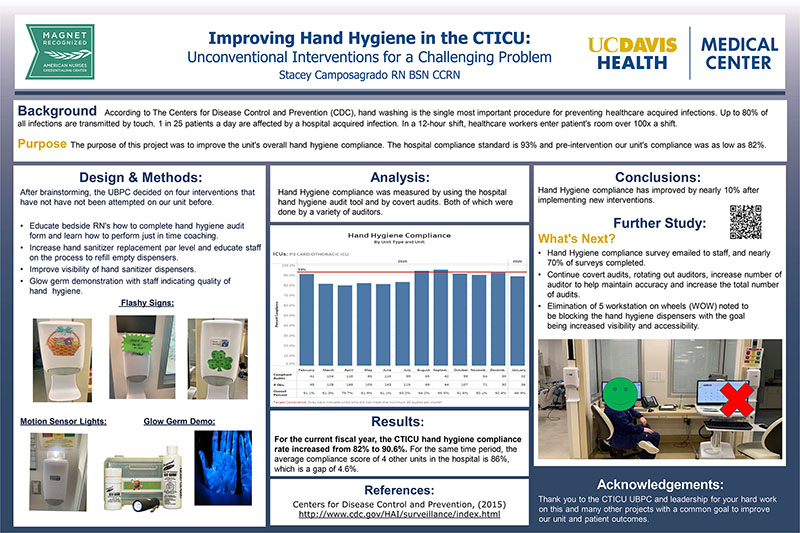
Hover to pan and click to magnify. Click again to pan at full screen.
Stacey
Camposagrado RN BSN CCRN
Stacey Camposagrado RN BSN CCRN
UC DAVIS HEALTH - QUALITY IMPROVEMENT
Background
According to The Centers for Disease Control and Prevention (CDC), hand washing is the single most important procedure for preventing healthcare acquired infections. Up to 80% of all infections are transmitted by touch. 1 in 25 patients a day are affected by a hospital acquired infection. In a 12-hour shift, healthcare workers enter patient's room over 100x a shift.
Purpose
The purpose of this project was to improve the unit's overall hand hygiene compliance. The hospital compliance standard is 93% and pre-intervention our unit's compliance was as low as 82%.
Design & Methods:
After brainstorming, the UBPC decided on four interventions that have not have not been attempted on our unit before.
• Educate bedside RN's how to complete hand hygiene audit form and learn how to perform just in time coaching.
• Increase hand sanitizer replacement par level and educate staff on the process to refill empty dispensers.
• Improve visibility of hand sanitizer dispensers.
• Glow germ demonstration with staff indicating quality of
hand hygiene.
Flashy Signs: (see poster)
Motion Sensor Lights: (see poster)
Glow Germ Demo: (see poster)
Analysis:
Hand Hygiene compliance was measured by using the hospital hand hygiene audit tool and by covert audits. Both of which were done by a variety of auditors.
(see poster)
Results:
For the current fiscal year, the CTICU hand hygiene compliance rate increased from 82% to 90.6%. For the same time period, the average compliance score of 4 other units in the hospital is 86%, which is a gap of 4.6%.
References:
Centers for Disease Control and Prevention, (2015) http://www.cdc.gov/HAI/surveillance/index.html
Conclusions:
Hand Hygiene compliance has improved by nearly 10% after implementing new interventions.
Further Study: What's Next?
• Hand Hygiene compliance survey emailed to staff, and nearly 70% of surveys completed.
• Continue covert audits, rotating out auditors, increase number of auditor to help maintain accuracy and increase the total number of audits.
• Elimination of 5 workstation on wheels (WOW) noted to
be blocking the hand hygiene dispensers with the goal
being increased visibility and accessibility.
Acknowledgements:
Thank you to the CTICU UBPC and leadership for your hard work on this and many other projects with a common goal to improve our unit and patient outcomes.

Present with Google Meet
Invite as many as 30 people, and present your poster in high definition. Transcription option is available. Free to use.
DISQUS COMMENTS WILL BE SHOWN ONLY WHEN YOUR SITE IS ONLINE